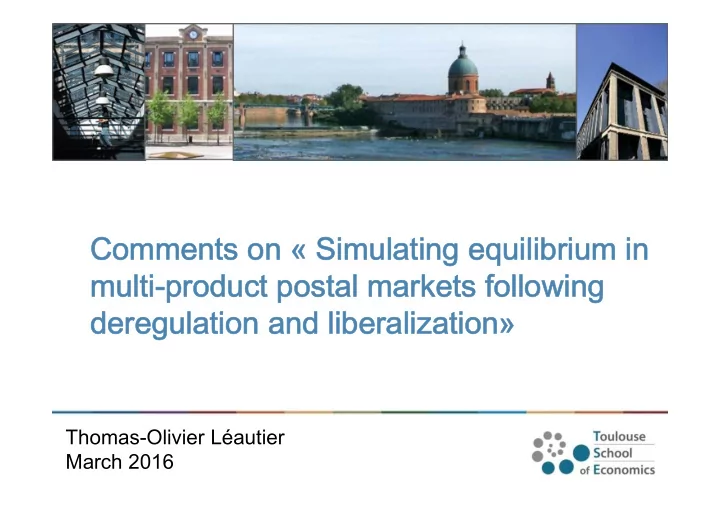

Comments on « Simulating equilibrium in multi-product postal markets following deregulation and liberalization» Thomas-Olivier Léautier March 2016
Summary of the work • Numerical simulation of Nash equilibrium in a liberalized postal market • Duopoly between an incumbent (PO or I) and an entrant (EC or E) • “Constrained” Nash equilibrium ― PO (i) must offer all products/services, hence strategy is a vector P I of prices, (ii) multiple choices of objective function (profit, revenues, etc.) ― EC (i) chooses which product/services to offer (among a legally feasible set), hence strategy is a set of products/services and a vector of prices for each of the selected product/service P E ― EC can play a mixed strategy equilibrium, i.e., randomize among which markets to enter • Cost and demand functions are assumed affine and calibrated on actual US data • Equilibrium is solved using an iterative procedure implemented in Excel 2
General comments • A very useful example of applied research ― Market opening is a happening (or will happen soon) ― It is essential to provide policy makers with some informed perspective on the resulting outcome • The reality of incumbent Postal Operator(s) is very well captured: multiple objective functions, regulatory limitations • However, a single EC (hence a duopoly) is less convincing. I some markets, we observe one incumbent and multiple entrants. How would the result change if you allowed for multiple ECs? 3
Detailed comments • Why is an iterative procedure required to find the fixed point? With affine demand and cost functions, is a closed form solution (i.e., invert a matrix in Matlab/Mathematica) not available? • In the iterative procedure, why does the incumbent use previous probabilities but reaction functions to current prices? • Why is the PO referred to as a price leader? This is a simultaneous game, even if is solved by sequential method • All strategies yield the same (expected) profit in a mixed strategy equilibrium. Could that result facilitate the analysis? • Why is the EC recording negative profit in the numerical simulation? 4
Recommend
More recommend